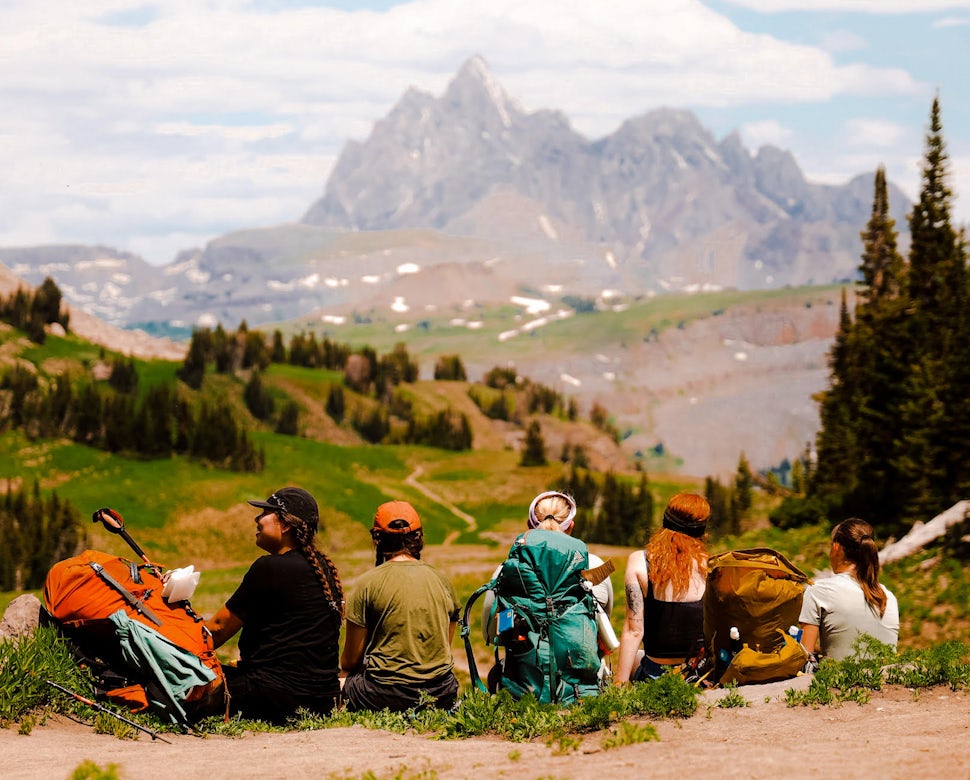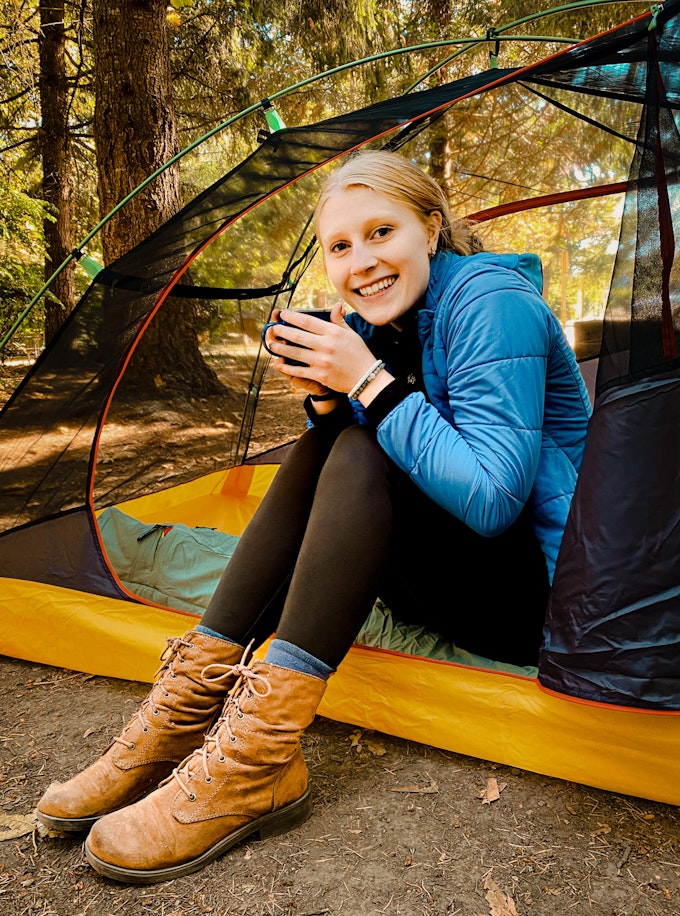Spotlight on Coleman Collective member Lea Hart

Presented by Coleman.
Lea Hart is an outdoor influencer and content creator who is a member of the Coleman Collective. We spoke to her about leading hiking and backpacking trips for young people, many of whom have never done these outdoor activities.
1. Why did you join the Coleman Collective? What are your goals while on the Coleman Collective, and how is Coleman helping you achieve those goals?
When Coleman asked me to join in their mission to make the outdoors for everyone, I couldn’t say no. My main goal for joining the Collective is use education as a tool to make the outdoors less intimidating for beginner campers, hikers, and backpackers. Secondly, to share about my selections from Coleman’s gear and share about the affordable-yet-quality mission I set out to share from the beginning.
Through the Reimagine Purpose project, Coleman has joined me in support my mission make the outdoors for everyone by providing gear for up to 12 people who attend my excursions. This project is actively lowering the cost barrier for people to get outdoors. It is so amazing to look back at my mission from the start and to be partnering with brands that support it.
2. Why do you think getting people outside is important?
I fell in love with the outdoors as a child. I grew up with my younger brother on several acres of land where we played imaginary games, went sledding, pushed each other on the swing, raised chickens, hiked to the river, raced four-wheelers and motorcycles, walked around the woods, went fishing, and spent most of our childhoods outside. We grew up before hand-held devices infiltrated childhood, so we were forced to use our imagination and our resources. The outdoors have always been important to me.
I needed the outdoors most when I started experiencing anxiety and depression in high school. I would spend most of my days after school outside playing sports, driving to a local state park to go on a hike, or going trail running. I always found that my brain slowed down a bit when I was in nature. As a doctoral student in Clinical Pyschology, I know that research studies show nature is beneficial to physical and mental health. Spending time in nature can lower cortisol (the pesky stress hormone) levels, increase your attentional capacity, and reduce your risk of developing a psychiatric disorder.
I think encouraging people to get outside goes beyond the personal health benefit. When people get outdoors, they are more likely to engage in protecting nature through conversation and environmental stewardship. My main encouragement is to lower the cost and safety barriers for women through education.

3. Why do you lead women-only trips? Or trips for college students involved in Residence Life?
My goal in encouraging women-identifying and non-binary identifying folks to get outside through these planned and facilitated trips is to make the outdoors more inclusive. Aside from physical limitations that may pose safety risks involved for specific activities, I encourage diversity in my groups. I emphasize beginner hiking and backpacking excursions, as well as more advanced excursions. Diversity can extend to gender, sexual orientation, cultural, age, disability, and race. My hope is to curate a safe space for everyone attending a trip.
There are a few reasons for my emphasis on women-identifying and non-binary identifying trips: (1) My experience in the outdoors is as a women, (2) women are often discouraged from getting outside due to discrimination, (3) women have often been excluded from outdoor spaces, and (4) women often feel most safe when exploring the outdoors with same-gendered groups. My goals are to uplift women through the educational content that I create on social media and empower them to explore nature (either together or alone).
I do offer co-ed trips with TrovaTrip, with an upcoming trip to Patagonia in March 2023 that is still open to all travelers. I also offer trips to undergraduate students working in Linfield University Residence Life, which includes male, female, and non-binary folks. I think co-ed trips can be fruitful in empowering male-identifying individuals to advocate for making the outdoors more inclusive.
4. What inspired you to focus on offering trips to beginner campers and hikers?
When I began to enter the outdoor space six years ago as a young single white woman, I felt very anxious. I sought out all the information I could. I watched YouTube videos, bought books, and read many articles. Much of the information I consumed wasn’t inclusive of all the information I needed to know. I would pull from six different sources to have all the information that I needed to know.
I also found that several platforms or even influencers marketed their tips to beginners without including information on Leave No Trace, safety, and navigation tips. Out of this frustration and anxiousness, I created my online presence three years ago with the goal to be a one-stop shop for hiking and backpacking information. I created a space and presence that welcomed and included everyone, especially those who have been marginalized from outdoor spaces. Obviously, I am a young single white woman, so no, I cannot speak for all marginalized voices, but I can amplify those marginalized voices.
I offer trips for all skill-levels of hikers and backpackers, but my passion is to connect with beginner campers and hikers in the outdoor space because the barriers to entry are high.
5. What are some common challenges you've seen most first-time campers/hikers have going into their first trips?
The most common challenges in skill development I’ve seen in most first-time campers and hikers are struggles with knowing what gear to use or buy, what to pack for trips, not knowing Leave No Trace Principles, how to dress for certain weather, not knowing how to navigate trails or find resources to navigate trails, and not knowing how to set up tents.
For beginner trips, I don’t expect anyone to know the above skills. The foundations of my social platforms and my excursions are to help educate folks by walking them through the skills and giving them a new baseline. Prior to trips, I send out details about weather, what to pack, and a fully planned itinerary. I integrate Leave No Trace principle discussions into our excursion, teach people how to set up campsites, and do camp chores. I create a shame-free space where people can ask any question they may have about camping.

6. How can people make the cost of camping more affordable?
To start, conscious consumerism lies at the core of making the cost of hiking gear affordable. I think that beginners often believe they need the “perfect” gear they see influencers promoting to enter the outdoor space. This type of “investing” or influencer-based-purchasing is purely marketing. I assume influencers only promote brands they genuinely love and use, but it’s also a job. It’s my job and morally, I never work with brands that I don’t love.
Most people are scared to get into hiking or backpacking because of this initial cost, which is expensive. Weekenders or one-timers buy the most expensive gear because they don’t know where to start or they want the “best” gear out there and can afford whatever the REI salesperson is willing to sell them, then most of that gear collects dust because they have no value placed in it other than someone marketed it well to them.
Investing in gear has less to do with price and more to do with spending the time to determine your personal preferences and values while you’re out on the trail. When it comes to gear, everything is up to a preference for the hiker.
The first thing I urge my followers to do, because I did it myself, is to establish a baseline budget for the activity. A budget dictates all the gear that you buy. After they have that budget, they need to write a list of their non-negotiables. Practicality, quality, comfort, and affordability are my top-tier preferences, then comes ethically made and aesthetic. Each of those preferences drives purchases for me. I ask myself: Does it fulfill the purpose that I need it to? Is it the highest quality product within my budget? Do the reviews say that it’s comfortable? Where you spend your money speaks about your values as a person.
I have a friend who is a blogger and aesthetics are important to her. But for me, I care less about aesthetics and more about practicality, quality, comfort, and affordability. I want my gear to keep me comfortable and I don’t want to break the bank. Within your budget, you can research brands and items that fit your preference. When you have the gear you are satisfied with, then you are not going to keep searching for different gear. You can buy expensive gear that everyone raves about, but if it can’t meet your needs, you will continue to search for the product that meets them.
Conscious consumerism and values-based shopping are just square one and two. Other ways to lower the initial cost of getting into any outdoor sport can include: borrowing gear from a friend, using what you already have, renting your gear from local shops or REI (if you’re a member), and buying used gear. Borrowing gear from a friend is free and allows you to try an activity out before you decide to invest thousands of dollars. Using what you already have can also make any sport more affordable. I used a 2 pound cook pot for backpacking before upgrading to something lighter. Renting your gear can give you the chance to try it before you buy it. Sometimes you need the experience with that type of product before you can make an informed purchase. My last suggestion I will mention is buying used gear. There are several extensions of websites like REI Re/Supply that offer used gear at fractions of the original price, several facebook gear swap groups, and even local gear swaps hosted by The Good Loop.
7. What are your favorite pieces of gear from Coleman that have been the most useful in a wide variety of situations (camping and non-camping)?
My tried and true Coleman products that will always come adventuring with me are the Coleman Two-Burner Propane Stove and the PEAK1™ 2-Person Backpacking Tent. Coleman’s Two-Burner Propane Stove is like having a traveling kitchen. Before purchasing this propane stove, I was using a tiny little backpacking stove and the meals were less than appetizing. But since investing in this stove in 2019, I have been cheffing up the most gourmet meals, like smash burgers, tacos, pancakes, you name it! If I am camping or recommending a tent to camp, I am recommending the PEAK1™ 2-Person Backpacking Tent. This tent was sent to me along with a set of five more to use while on hiking and backpacking trips. It has a lightweight design at a fraction of the cost of similar tents and will be another lifetime gear find!
8. Where can we learn more about your work and trips?
The best places to view my work and learn more about my trips are my TikTok, Instagram, and my Website.
We want to acknowledge and thank the past, present, and future generations of all Native Nations and Indigenous Peoples whose ancestral lands we travel, explore, and play on. Always practice Leave No Trace ethics on your adventures and follow local regulations. Please explore responsibly!
Do you love the outdoors?
Yep, us too. That's why we send you the best local adventures, stories, and expert advice, right to your inbox.








